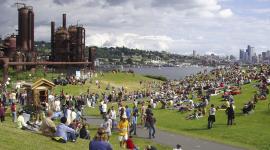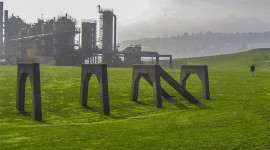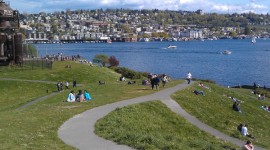Landslide Update: Gas Works Park
As previously reported by The Cultural Landscape Foundation (TCLF) Seattle’s Gas Works Park is a significant example of Richard Haag’s innovative landscape architecture and listed in the National Register of Historic Places (2013). Built on the location of a former coal gasification plant, the park is a seminal project that shifted public perceptions of post-industrial landscapes. Recently, the city has called for the extensive removal of piping, catwalks, ladders, and support systems from the site’s prominent “Cracking Towers” and engaged local firm Osborn Architects Inc. to prepare plans. The adverse effects of such removals and alterations would substantially alter the integrity of this rare, surviving industrial artefact.

In response to the current proposals that are the subject of the public review by the Landmarks Preservation Board on September 25, 2025, TCLF submitted a letter to Erin Doherty, Landmarks Coordinator, Seattle Department of Neighborhoods, requesting “that Seattle Parks and Recreation propose a solution that addresses those [safety] challenges without creating any adverse impacts on the historically significant Seattle Landmark and National Register designated property.” The letter recommends that the city follow The Guidelines for the Treatment of Cultural Landscapes, which concludes with a series of Special Requirements that are organized under the following considerations: accessibility, energy, environmental, and health and safety (The specific guidance for health and safety that are part of the Standards for Rehabilitation can be found on this page if you scroll down).
What You Can Do to Help:
Submit a public comment to the city’s Landmarks Preservation Board prior to their board meeting on October 15, 2025, advocating for the city to rehabilitate the park’s structures following The Guidelines for the Treatment of Cultural Landscapes. A copy of the letter, submitted by TCLF’s President, Charles A. Birnbaum is reproduced below.
September 25, 2025
Ms. Erin Doherty, Landmarks Coordinator
Seattle Department of Neighborhoods
P.O. Box 94649
Seattle, WA 98124-4649
Dear Ms. Doherty:
Thank you for this opportunity to offer comments on the briefing packet for “Cracking Towers at Gas Works Park.”
Gas Works Park, on the shores of Lake Union in Seattle, was designated a Seattle Landmark in 1999 and listed in the National Register of Historic Places in 2013. Richard Haag, the landscape architect of this seminal work of landscape architecture, (one that is likely a candidate for designation as a National Historic Landmark), understood the critical nature of how to manage change at the proposed park—referring to his work as “thinning the forest”—a reflection of how he edited the conglomeration of industrial towers, stacks, pipes, and sheds.
Foundational to considering the current proposals to alter the gas works structures, the Seattle Landmark nomination’s statement of significance notes the following:
“GWP is a unique landmark for the City of Seattle. The original structures qualify as industrial archaeology and are the last remaining examples of a type of technology. These structures have been doubly served by Gas Works Park for not only have they been preserved but they have been integrated into an innovative, ground-breaking park design. Paul Goldberger wrote in the New York Times, ‘Seattle is about to have one of the nation’s most advanced pieces of urban landscape design. The complex array of towers, tanks and pipes of the gas works forms a powerful industrial still life . . . serving both as a visual focus for the park and as a monument to the city’s industrial past. The park represents a complete reversal from a period when industrial monuments were regarded, even by preservationists, as ugly intrusions on the landscape, to a time when such structures as the gas works are recognized for their potential ability to enhance the urban experience.” (New York Times, August 30, 1975)
Goldberger’s statement, made slightly more than fifty years ago and still relevant, powerfully articulates the significance of the industrial artefact and its purposeful transformation in this pioneering work of landscape architecture. This significance and inherent integrity, as well as the Seattle Landmark and National Register designations, should serve as a baseline when addressing the current health and safety concerns where any proposed actions should make every effort to avoid, minimize and mitigate adverse effects on the designated property.
The Guidelines for the Treatment of Cultural Landscapes (U.S. Department of the Interior, National Park Service, Birnbaum, 1996), which applies the Secretary of the Interior’s Standards to all four treatment standards, concludes with a series of Special Requirements that are organized under the following considerations: accessibility, energy, environmental, and health and safety. When considering the health and safety guidelines for example, each of the four treatment standards concludes with suggested guidance in the form of Recommended and Not Recommended approaches to project work. As this is a rehabilitation project, it’s worth noting the guidance listed for applying the Standards for Rehabilitation, offers the following suggestions as a starting point:
- Identifying the cultural landscape’s character-defining features, materials, and finishes so that code-related work will not result in their damage or loss;
- Complying with health and safety code requirements in such a manner that character defining features, materials and finishes are preserved. For example, recognizing standards for the application of herbicides;
- Removing toxic materials only after thorough testing has been conducted and only after less invasive abatement methods have been shown to be inadequate;
- Providing workers with appropriate personal protective equipment for hazards found in the worksite;
- Working with local code officials to investigate systems, methods, or devices of equivalent or superior effectiveness and safety to those prescribed by code so that unnecessary alterations can be avoided;
- Upgrading character-defining features to meet health and safety codes in a manner that assures their preservation. For example, upgrading a historic stairway without destroying its character-defining handrails and balustrades;
- Installing safety-related systems that result in the retention of character-defining features, materials, and finishes; for example, fire-suppression systems or seismic retrofits;
- Applying the necessary materials to add protection to character-defining features, materials and finishes. For example, applying fire retardant, intumescent paint coatings to a deck to add thermal protection to its steel;
- Adding new features to meet health and safety codes in a manner that preserves adjacent character-defining features, materials and finishes. For example, providing a new fire access route along a derelict historic corridor.
We recognize there are legitimate safety concerns, but request that Seattle Parks and Recreation propose a solution that addresses those challenges without creating any adverse impacts on the historically significant Seattle Landmark and National Register designated property. Please feel free to reach out to us if we can be of further assistance.









